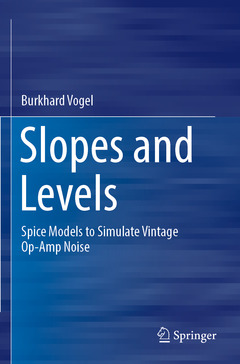Description
Slopes and Levels, 1st ed. 2022
Spice Models to Simulate Vintage Op-Amp Noise
Language: English
Subject for Slopes and Levels:
Publication date: 05-2023
333 p. · 15.5x23.5 cm · Paperback
Publication date: 05-2022
333 p. · 15.5x23.5 cm · Hardback
Description
/li>Contents
/li>Biography
/li>Comment
/li>
This book features an extensive index and all Mathcad worksheets.
Vinyl is back, tubes/valves are back, on the high-end field SMD-free analog amplification surpasses digitalized chains, and top microphone manufacturers still set on good old op-amps or on fully discrete BJT, FET, and/or tube-driven amplifiers. There is only one problem that is not satisfyingly well solved by the manufacturers: It is the noise production of the active components and the useful reflection in simulation tools, in tables or graphs of the datasheets/data books.
Nowadays, mostly surrounded by many digital helping tools, it makes sense using them?also by analog aficionados. It saves cost and time simulating first before spending money. Presented in this book the software tool LTSpice which is the free software solution from Linear Technology (today Analog Devices) that could also be used by full analog lovers to simulate the noise production of their amplifier design. All we need is the right creation approach to develop simulation models for the active components. Inter alia this is already done for tubes and BJTs in the 2nd editions of my ?How to Gain Gain? and ?Balanced Phono-Amps? books. For op-amps, the missing approaches are presented in the book on hand.
It cannot be denied that mathematical software like Mathcad is extremely helpful to find the right equations for graphically presented noise curves which we can find in the literature. Nevertheless, it also works well with other types of math software to fulfill the parameter needs of the here presented modeling approaches for the input referred voltage and current noise of?not only?excellent sounding vintage op-amps, applicable in the audio range from 1 Hz to 100 kHz.
Burkhard Vogel achieved the degree Diplom-Ingenieur (Telecommunications) from Darmstadt University of Technology, Germany, in 1973. He then decided to follow a general management career path in the high-tech and IT industry in Germany, Switzerland, and Austria. His passion for music and music systems made Mr. Vogel an expert in Phono-Amps and Vinyl Technology. In addition to “Slopes and Levels,” he wrote the RIAA-phono-amp designer guides “The Sound of Silence” and “Balanced Phono-Amps,” rounded up by the triode reference “How to Gain Gain”.

